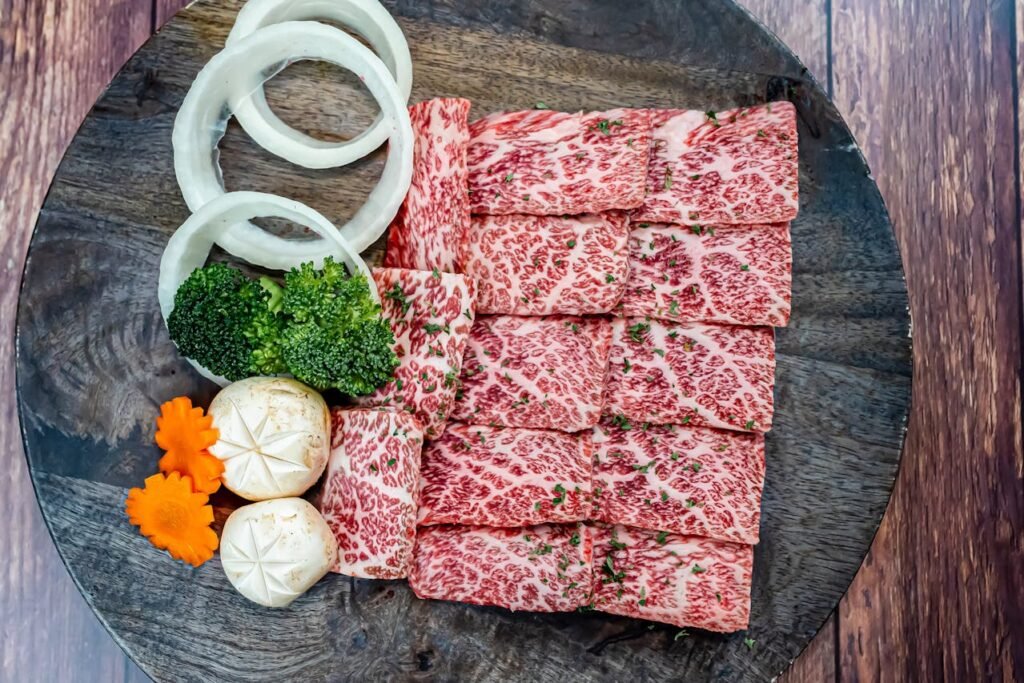
Why This Japanese Wagyu Collection Stands Out Among Imports
The allure of Japanese Wagyu is deeply rooted in centuries of selective breeding and meticulous husbandry practices that have shaped its unparalleled character. Unlike conventional beef, Wagyu originates from specific breeds such as Kuroge Washu, renowned for their predisposition to intramuscular marbling. Generational ranchers in Japan have developed sophisticated techniques to enhance this marbling, ensuring each cut achieves remarkable tenderness and flavor depth. The combination of genetic heritage and cultural dedication forms the cornerstone of Wagyu’s prestige in global markets.
While many countries have attempted to replicate Wagyu production, the authenticity of Japanese Wagyu remains unmatched due to its stringent regulatory framework. Every animal is meticulously tracked through a detailed lineage system that verifies origin and breed purity. This traceability guarantees that the beef labeled as Japanese Wagyu upholds the legacy that consumers expect when they invest in premium cuts. Such regulatory oversight preserves the integrity of the product and reinforces its status as the gold standard among beef imports.
Culinary experts often emphasize that true Japanese Wagyu represents not only a delicacy but also an embodiment of cultural artistry. The cattle are often raised in low-stress environments, fed carefully curated diets, and even receive individual care to promote optimal health and flavor development. This level of attention to detail is seldom observed in other beef production systems worldwide. As a result, discerning consumers consistently regard Japanese Wagyu as a singular benchmark for quality and refinement.
The Art of Marbling: A Distinctive Signature
One of the most defining characteristics of Japanese Wagyu is its extraordinary marbling, which elevates it far beyond other imported beef. The fine, lace-like streaks of fat that weave through the muscle fibers are responsible for its signature melt-in-your-mouth texture. Unlike conventional beef, the marbling in Wagyu begins developing at an early stage due to the breed’s unique genetic makeup. As the cattle mature, the fat distribution becomes even more intricate, creating an experience that feels as delicate as it is rich.
Marbling plays a pivotal role not just in taste but also in how Wagyu is cooked and presented on the plate. When prepared properly, the intramuscular fat renders gently, infusing the beef with a luscious succulence that amplifies its natural umami. This effect is rarely duplicated by other beef imports, whose marbling often lacks the same evenness and density. Such differences underscore why Wagyu commands a premium and is regarded by chefs worldwide as a superior product worthy of special occasions and elevated menus.
American enthusiasts searching for genuine Japanese Wagyu now have access to exclusive collections that celebrate the beef’s remarkable heritage and flavor. Premium online Wagyu retailers such as Destination Wagyu bring the unrivaled taste of Japanese Wagyu directly to discerning consumers, making it possible to select cuts with confidence, knowing each piece reflects the highest standards of authenticity. Carefully sourced from renowned producers, these cuts arrive beautifully prepared to highlight the delicate balance of marbling and texture. Curious diners can now enjoy an experience once reserved only for exclusive restaurants, right at their own table.
Regional Variations Elevate Distinctiveness
The uniqueness of Japanese Wagyu also lies in the diversity of regional styles, each of which brings subtle variations to the dining experience. Prefectures such as Miyazaki, Kagoshima, and Hyogo have developed reputations for producing Wagyu with distinct flavor profiles and textures. These differences result from not only the genetic strain but also the specific climate conditions, feeding practices, and traditions that have been preserved over generations. In Hyogo, for example, the Tajima strain forms the basis for the iconic Kobe beef, which has become synonymous with indulgence.
The terroir of each region imbues the beef with characteristics as nuanced as fine wine. Kagoshima Wagyu is often recognized for its robust marbling and buttery finish, while Miyazaki Wagyu tends to display a more delicate texture balanced by a clean, lingering sweetness. Consumers exploring these variations quickly realize that Japanese Wagyu is not a monolith but rather a dynamic collection of regional expressions. Each cut offers a different perspective on how environment and craftsmanship converge in remarkable ways.
Such regional distinctiveness has spurred intense competition among breeders and producers to perfect their cattle-raising techniques. Annual competitions in Japan rank Wagyu from different areas on metrics such as marbling, color, firmness, and flavor. The accolades awarded at these contests significantly influence demand in global markets, reinforcing the perception that Japanese Wagyu stands apart from other imports. As awareness of these regional identities grows, more consumers are learning to appreciate the layered story each piece of Wagyu tells.
The Rigorous Grading System Sets the Benchmark
Japanese Wagyu’s reputation for excellence is further reinforced by a grading system that surpasses any other in precision and rigor. The Japan Meat Grading Association evaluates beef according to strict criteria that consider yield, marbling, color, firmness, and fat quality. The marbling score alone ranges from 1 to 12, with the highest grades representing the most exquisite levels of intramuscular fat. This scoring system allows buyers to understand exactly what they are purchasing, establishing transparency and trust in the supply chain.
Beyond marbling, the beef’s overall quality grade is expressed by combining a letter from A to C and a number from 1 to 5. An A5 grade denotes the pinnacle of Wagyu, signifying maximum yield and unparalleled meat quality. This dual grading standard ensures that only cattle achieving the most demanding benchmarks can be labeled as top-grade Wagyu. For importers, such distinctions are essential because they clearly communicate the value proposition to discerning customers. The clarity provided by this grading helps maintain the product’s prestige and prevents dilution by lesser-quality offerings.
Because of this uncompromising evaluation process, even small variations in grade can lead to substantial differences in market price and culinary experience. A piece of A5 Wagyu commands a premium not simply because of rarity but because it represents the culmination of meticulous care and rigorous selection. This standardized approach to grading has become a model for other countries attempting to emulate Japanese Wagyu production. However, few have managed to replicate the system’s comprehensiveness and credibility.
Sustainable Practices Preserve Tradition
The rise in global demand for Japanese Wagyu has spurred significant conversation around sustainability and responsible production. Japanese producers have long recognized that the health of the cattle and the preservation of heritage breeding lines are inseparable from environmental stewardship. Many ranches implement rotational grazing practices and specialized feed cultivation that minimize environmental impact while supporting animal welfare. These practices not only protect natural resources but also contribute to the distinctive taste and quality of the beef.
Sustainability efforts extend to genetic preservation as well. In Japan, rigorous policies prevent the over-commercialization of prized bloodlines, ensuring that breeding programs remain focused on quality rather than quantity. By limiting exports of live cattle and carefully managing breeding stock, producers can maintain the genetic integrity that defines authentic Wagyu. This commitment to preserving heritage breeds is a critical factor distinguishing genuine Japanese imports from crossbred or imitation Wagyu found elsewhere.
Furthermore, producers have invested in innovative waste management and resource-efficient operations to reduce their carbon footprint. These sustainability measures resonate with a growing consumer base that prioritizes environmentally conscious sourcing. By aligning traditional animal husbandry with modern ecological awareness, Japanese Wagyu producers continue to set a global benchmark for responsible luxury food production. This combination of heritage and innovation underscores why the collection stands apart.
Culinary Versatility Elevates Every Meal
The versatility of Japanese Wagyu in culinary applications is another factor contributing to its exceptional standing among imported beef. Chefs worldwide prize its ability to transform even the simplest preparations into memorable dining experiences. Whether seared lightly as tataki, grilled to perfection as steak, or incorporated into shabu-shabu and sukiyaki, the beef delivers a depth of flavor that few proteins can rival. Its high marbling content ensures that the meat remains tender and succulent across a range of cooking methods.
Home cooks increasingly recognize that Wagyu does not require elaborate seasoning or complicated techniques to shine. The richness inherent in the beef speaks for itself when prepared with restraint. A light sprinkle of sea salt and a precise sear are often all that is necessary to highlight its delicate sweetness and buttery finish. This simplicity aligns with contemporary preferences for ingredient-driven cuisine that showcases natural qualities rather than relying on embellishment.
Moreover, Wagyu’s versatility extends beyond traditional Japanese preparations. In modern fine-dining establishments, chefs are incorporating Wagyu into dishes inspired by French, Italian, and American culinary traditions. From carpaccio to burgers, the meat adapts seamlessly while elevating each dish’s profile. This adaptability makes Japanese Wagyu a prized ingredient for restaurants seeking to distinguish their menus with a singular product that combines heritage, luxury, and universal appeal.
The Future of Japanese Wagyu Imports
As consumer awareness and appreciation for authentic Japanese Wagyu continue to expand, importers face both opportunities and challenges in meeting demand. Supply constraints, combined with complex export regulations, create a marketplace where availability can fluctuate significantly. To address these issues, many distributors are forging closer relationships with producers in Japan to secure consistent access to high-grade beef. This collaboration is essential to ensure that quality remains uncompromised even as volumes grow.
Technology is also playing a role in shaping the future of Wagyu imports. Advanced logistics solutions, such as temperature-controlled shipping and blockchain-based tracking, are enhancing the transparency and efficiency of global supply chains. These innovations support the preservation of freshness and authenticity during transport, addressing longstanding concerns about maintaining quality across long distances. As infrastructure evolves, more consumers will have the opportunity to experience genuine Japanese Wagyu as it was intended.
Looking ahead, education will be vital in sustaining the prestige of Japanese Wagyu. Importers and retailers alike are investing in storytelling and outreach initiatives that communicate the beef’s heritage, grading, and culinary potential. By fostering a deeper understanding of what sets Japanese Wagyu apart, they can cultivate loyal customer bases willing to invest in an unparalleled gastronomic experience. This commitment to transparency and education will ensure that Wagyu’s reputation as the world’s most esteemed beef endures for generations.

